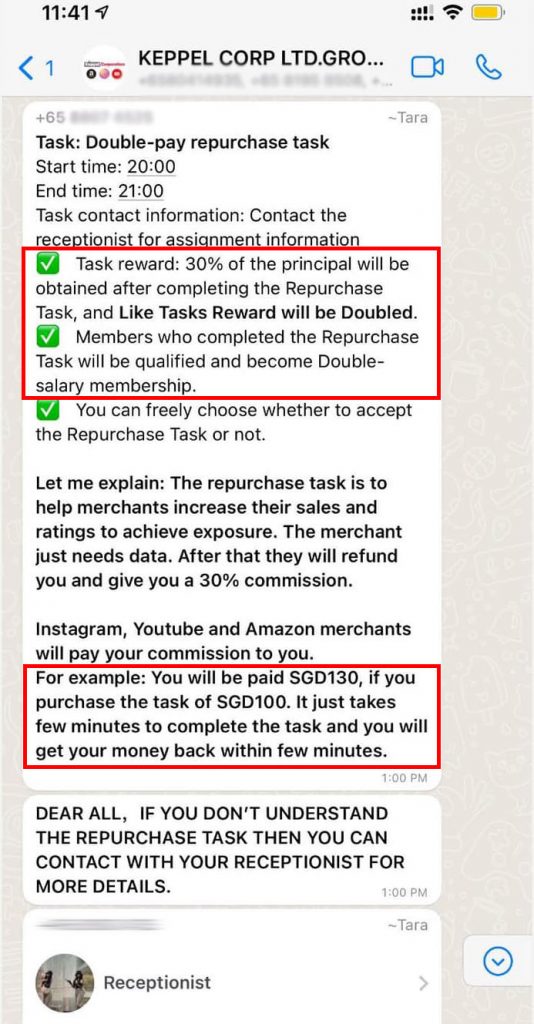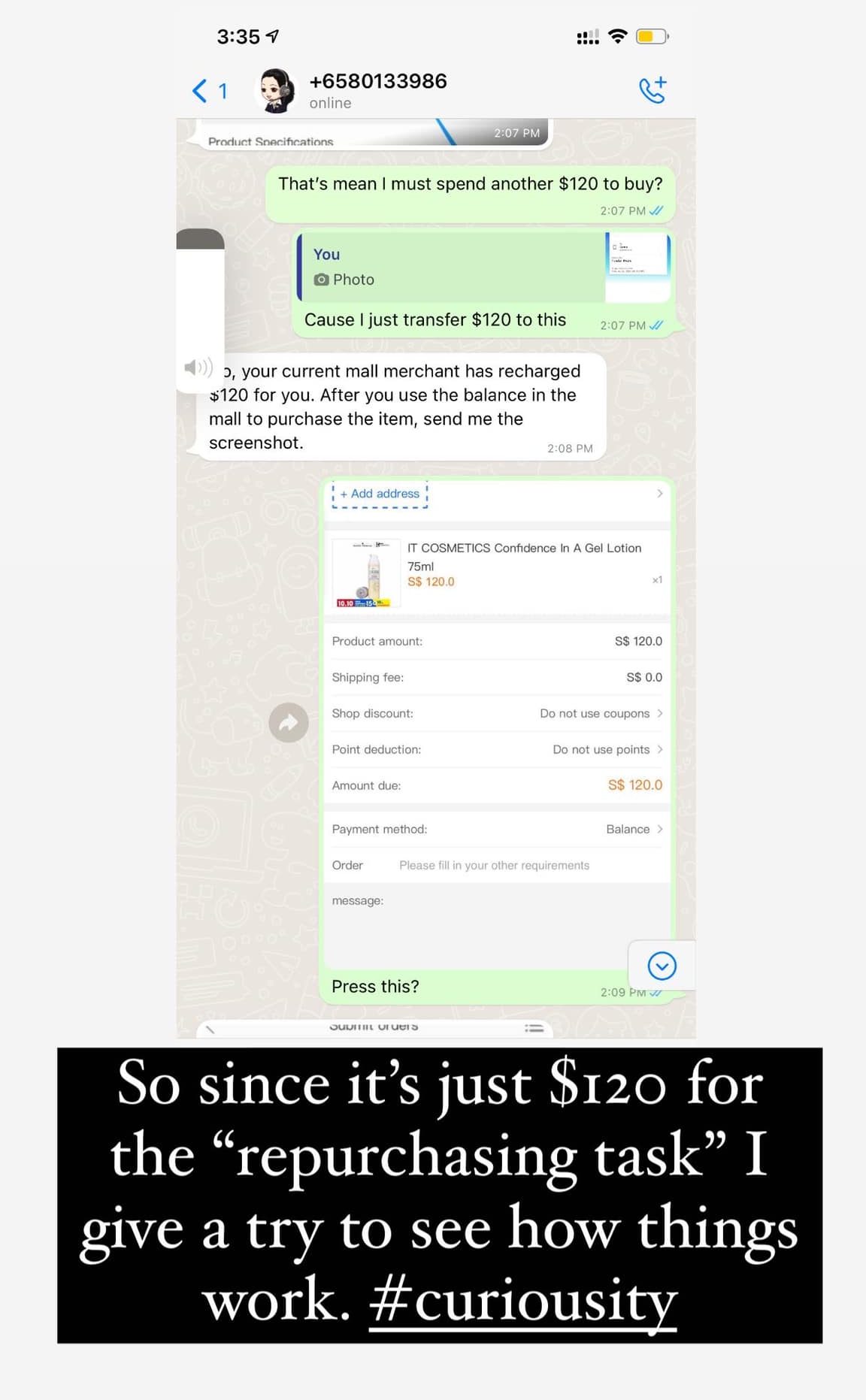Given the amount of time we tend to spend scrolling through social media—though it varies from person to person—we’ve been exposed to a lot of advertisements.
Heck, we might be so desensitised to pop-up ads that our fingers move faster than the speed of light to tap away from the ad before our brain can fully process it the action, because we’ve done it so many times.
But there are some ads like “This Singaporean Made $1 Million In A Day!” or remote part-time jobs that offer a ridiculous amount of money for work that requires minimal efforts like these:

It’s almost like money is starting to grow from virtual trees….
In any case, one Singaporean lady by the name of Janice Sia became intrigued by the advertisement she was served on Tiktok
No, not because she fell for the scam and was enticed by the monetary incentive—
But because of simple curiosity: Just how do these e-commerce scams work?
Well, through some covert infiltration, Janice has found the answer to that question.
Step 1: Recruitment via Social Media
Compared to the older scams where scammers tend to robo-call every possible number combination or send out mass e-mails, this e-commerce scam starts with a simple post on social media.
It states that it’s a part-time job that can be easily accomplished, with the large sum of daily pay-out of “SGD 50 ~ SG 350+” purposefully bolded to draw your attention.
It sounds almost too good to be true, right?

However, for the scammers, it’s still a game of large exposure and numbers, and waiting for their possible victims to take the bait.
So how do they make themselves appear convincing?
Step 2: Pretending to Be a Legitimate Organisation
After Janice contacts the number that she was given, the person introduced themselves as a company representative of “blah-blah CORP LTD/PTE LTD”, and that they are sponsored by reputable companies like Amazon, YouTube, and Instagram.
Hey, why don’t you add Google, Baidu, QQ, WeChat, and SnapChat while you’re at it? You should cover all the bases while you’re at it.
This is just the first move to establish their “legitimacy”.

The victim will then be told to fill out some basic personal information, like your contact number, age and work experience.
It sounds like a matter of course, as if it was a simple job interview to get to know your background at least.
But it’s also an important step for the scammers to see if you’re a potential target.
If you’re younger than 16, then chances are you don’t even have your own debit card and the scam can’t even start, so expect that you’ll be ignored afterwards.
If you’re older than 16 and have little to no work experience, well, that makes you a prime target because it’s always good to take advantage of your innocence.
Step 3: Making the Victim Join the “Legitimate” Group
Afterwards, the victim will be pulled into a new group that has many other numbers to make it seem like it’s a legit company and there are many persons involved.
The newest member will be given a bulk of instructions for how the job works, and will be actively encouraged to participate in all the opportunities for cash grabs/getting scammed.

Step 4: Dangling the First Small Bait
In order to hook in the victim and show them “how quickly” they can make money, the first task given is laughably easy.
The victim will be told to like a certain number of posts on an Instagram account, and then sending it to “Ms Jenny” for the PayNow salary payment.
It’s simple and yet you get to earn $2.

The scammers will continue to link you to various personnel to make it appear as though that there’s a chain of command, and that the company is the real deal.
Join our Telegram channel for more entertaining and informative articles at https://t.me/goodyfeedsg or download the Goody Feed app here: https://goodyfeed.com/app/
Step 5: Promising More Commissions
I hope the readers are keeping count, because at this point, the scammers are making a small loss of $2.
But the stakes are still small, and the victim isn’t fully hooked yet.
The e-commerce scam moves to its next stage where the victim will be made to part with a small amount of their money, with the promise that they’ll get more money in return afterwards.
The second task will require the victim to “purchase” an item.
In this case, Janice is being made to buy some bogus cosmetic product that costs $120 from “Amazon”, but with the refund money policy and 30% commission, it gives the appearance that the victim will only be making more money instead of losing.


Janice decided to go ahead with the purchase to see where the scam was going.
Step 5: Honouring the Monetary Compensation (At First)
To her surprise, the payout arrives as promised.
After the money is transferred to the victim, they get a taste of what it’s like to make the easy money.
Surely by now, the victim would be thinking that “this is real”, because the quick money deposit is right in front of their eyes.

At this point, it means that the victim has made $158 from the scammers, while the scammer is at a complete loss.
So how do the scammers recoup their losses?
Step 6: Offering Bigger Money Grabs
The fraud reaches its crucial stage.
The scammers will ask the victims to do more repurchasing tasks—ergo parting with more of their money—but with the reassurance that they will get refunded the full price, with the 30% principal commission fee still being valid.
But the “products” that the victims will be asked to purchase will get more and more expensive.

These shoes cost S$520, which means that the scammers would be getting back three times the amount that they previously gave you. This is also the sum of money that you are very likely to lose.
Because remember, you’re relatively young and you don’t have that much money in your bank accounts in the first place. Additionally, you might be close to hitting the limit of what your debit/credit card allows you to fork out at any given transaction.
Please also note that the website link “amzonshop.xyz” is very much fake.
And if the “site” requires your debit/credit card information, then the scammers would have completely won because the site is theirs, and they now have access to your banking account information.
Step 7: No Backing Out
Since Janice is well-aware that this is a scam, she refuses to make the larger repurchases and asks If she can go back to the “likes” task.

Of course, there’s no chance in hell that will happen, because the scammers want the victims to do the repurchasing task. They want the victim to continuously fall for this trap where the victims are constantly making transactions with them.
The reasons for that are as follows:
- The scammers are now operating at a loss of $158; if the victim doesn’t go for the next step, it will be quite difficult for them to get back the money
- To see if the victims have other bank accounts that they can tap into
- It gives the scammers an insight into how financially capable their victims might be
- With the rough information gathered, it gives scammers a gauge of the maximum amount of money they can extort from their victims
Because remember, the scam will end once the scammers refuse to refund the money.
Therefore, the scammer will pressure the victim to do the repurchasing task.
In this instance, the scammer will try to be nice and use words like “please” and “dear” to try and coax the victim into doing their bidding.
At some point, the scammer even accuses Janice with the line, “Are you bullying me dear?”
Janice rightly responds with a “WTF” in her mind and probably ignores the scammer afterwards.
Step 8: Continuous Bombardment
The main issue with all kinds of scams is that the scammer can never force the victims into doing their bidding.
This has also got to do with the failsafe that banks have put in place, like the One-Time Passwords (OTPs) for online purchases or needing constant agreements on online banking services applications to make the transaction work.
Therefore, if the would-be victim decides to stop at any given time (while they still have their money), there is really nothing the scammers can do about it.
The only tactic they can employ is to irritate the victims by constantly sending out messages and reminding them that they are a legitimate organisation, and they could be making so much more money if they just complied with the instructions.

Of course, being the smart lady that Janice is, she ignores all of it and ghosts them, while keeping her ill-begotten gains of $38 without a single shred of guilt.
Kudos to Janice.
Singapore Police is On the Case
On 20 March, the Singapore Police Force declared that they arrested 8 men who are suspected to be involved in such e-commerce online scams.
They were all aged around 18 to 30.
The investigations started after police received reports between Dec 2021 and Mar 2022 about victims getting spontaneous WhatsApp/Facebook/Telegram messages with advertisements that were advertising highly paid part-time jobs that were related to product marketing.
The general scheme of the scam remains the same, where the victims will be eased into the “job” with simple tasks first before being made to do “online purchases”, when they were really just transferring money to the scammers.
The more insidious part about these scams is that victims would even be directed to recruit more members into the “organisation” to upgrade their own membership status.
… This is worse than the Multi-Level Pyramid scheme, wow.
When there were no further tasks issued, or when victims are no longer able to make withdrawals from their member accounts, they would only then realise that they have been scammed.
Nefarious.
Read Also:
- Man Claims That His Unborn Child Dies Due to NUH’s Delay in Attending to His Pregnant Wife
- 11-Second Video of a Woman Saying That a Man Named After MRT Station Made Her Cry Got Over 500k Views
- Mediacorp Actor Leon Jay Williams Slams Article That Calls Her Daughter Ugly
- CNB Officer Found Guilty of Hitting Suspect in a Toilet to Extract a Confession
Featured Image: Facebook (Janice Sia)



